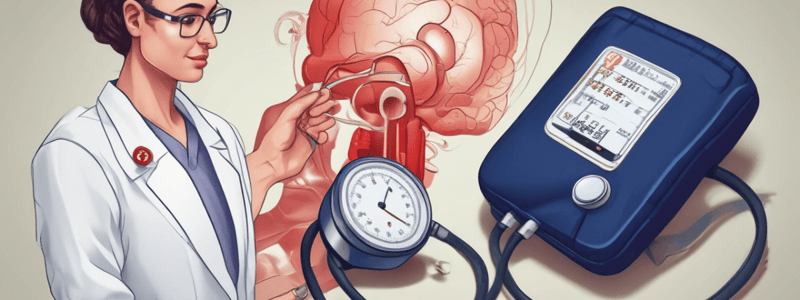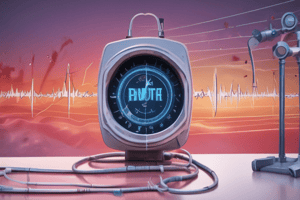Podcast
Questions and Answers
What percentage of the arm circumference is the bladder of a blood pressure cuff?
What percentage of the arm circumference is the bladder of a blood pressure cuff?
- 50%
- 20%
- 30%
- 40% (correct)
Which artery is typically used for blood pressure measurement?
Which artery is typically used for blood pressure measurement?
- Dorsalis pedis artery
- Popliteal artery
- Radial artery
- Brachial artery (correct)
What is the purpose of assessing blood pressure?
What is the purpose of assessing blood pressure?
- To monitor the effect of medication
- To assess vascular resistance
- To obtain a baseline measure of arterial blood pressure for subsequent evaluation (correct)
- To diagnose hypertension
What is Phase 1 of Korotkoff's Sounds in blood pressure measurement?
What is Phase 1 of Korotkoff's Sounds in blood pressure measurement?
What is the correct position of the client's arm during blood pressure measurement?
What is the correct position of the client's arm during blood pressure measurement?
What is the minimum width requirement for the blood pressure cuff?
What is the minimum width requirement for the blood pressure cuff?
What is the nurse's responsibility during blood pressure measurement?
What is the nurse's responsibility during blood pressure measurement?
Why is it important for the client to avoid caffeine and smoking 30 minutes before blood pressure measurement?
Why is it important for the client to avoid caffeine and smoking 30 minutes before blood pressure measurement?
What happens to the arteries when elastic and muscular tissues are replaced with fibrous tissue?
What happens to the arteries when elastic and muscular tissues are replaced with fibrous tissue?
What is the effect of increased blood volume on blood pressure?
What is the effect of increased blood volume on blood pressure?
What is the effect of high blood viscosity on blood pressure?
What is the effect of high blood viscosity on blood pressure?
What is the effect of age on blood pressure?
What is the effect of age on blood pressure?
What is the effect of exercise on blood pressure?
What is the effect of exercise on blood pressure?
What happens to the arteries when the proportion of red blood cells to plasma increases?
What happens to the arteries when the proportion of red blood cells to plasma increases?
What is the main factor that determines peripheral resistance in the arterial system?
What is the main factor that determines peripheral resistance in the arterial system?
Which of the following is a result of increased vasoconstriction?
Which of the following is a result of increased vasoconstriction?
What is the term for a blood pressure that is persistently above normal?
What is the term for a blood pressure that is persistently above normal?
Which of the following is a factor that can increase blood pressure?
Which of the following is a factor that can increase blood pressure?
What is the pressure of the blood when the ventricles are at rest?
What is the pressure of the blood when the ventricles are at rest?
Which of the following is not a factor that determines peripheral resistance?
Which of the following is not a factor that determines peripheral resistance?
What is the term for the thickening and stiffening of the arteries?
What is the term for the thickening and stiffening of the arteries?
What is the normal blood pressure measurement?
What is the normal blood pressure measurement?
Flashcards are hidden until you start studying
Study Notes
Blood Pressure Measurement
- The bladder of a blood pressure cuff should be 40% of the arm circumference or 20% wider than the diameter of the midpoint of the limb.
- Appropriate sizes of the length of the bladder cuff are:
- Newborn
- Infant
- Child
- Adult
- Large adult
- Thigh
Blood Pressure Assessment Sites
- Brachial artery: taken on the upper arm, mostly
- Radial artery: taken on the lower arm, possible site for infants or clients with a very large upper arm
- Popliteal artery: taken on the thigh
- Dorsalis pedis and posterior tibial: taken on the lower leg
Korotkoff's Sounds
- Phase 1: first faint clear tapping sounds are heard
- Phase 2: sounds have a swishing quality
- Phase 3: sounds are crisper and more intense
- Phase 4: sounds become muffled and have a soft, blowing quality
- Phase 5: sounds disappear
Assessing Blood Pressure
- Purpose: to obtain a baseline measure of arterial blood pressure for subsequent evaluation
- Assessment: signs and symptoms of hypertension, hypotension, and factors affecting blood pressure
- Preparation:
- Equipment: stethoscope, sphygmomanometer, and blood pressure cuff
- Patient: client has not smoked or ingested caffeine within 30 minutes, bladder of the cuff must be at least ⅔ of the arm, and arm should be flexed with the palm of the hand facing up and the forearm supported at heart level
- Nurse: introduce themselves, explain the procedure, and ask the patient's name and birth date
Blood Pressure Concepts
- Blood pressure: the pressure of blood pushing against the walls of arteries
- Arterial blood pressure: a measure of the pressure exerted by the blood as it flows through the arteries
- Systolic pressure: the pressure of the blood as a result of contraction of the ventricles
- Diastolic pressure: the pressure when the ventricles are at rest
- Pulse pressure: the difference between the diastolic and systolic pressures
- Arteriosclerosis: occurs when the arteries that carry oxygen and nutrients from the heart to the rest of the body become thick and stiff
- Hypertension: a blood pressure that is persistently above normal
- Hypotension: the blood pressure is below normal
Measurements of Blood Pressure
- Normal blood pressure: 120/80 mmHg
Factors Determining Blood Pressure
- Pumping action of the heart:
- Weak pumping action: low cardiac output and BP
- Strong pumping action: high cardiac output and BP
- Peripheral vascular resistance:
- Increased peripheral resistance: increases blood pressure, especially diastolic pressure
- Factors that create resistance: capacity of arterioles and capillaries, compliance of the arteries, and viscosity of the blood
- Blood volume:
- Decrease in blood volume: decrease in BP
- Increase in blood volume: increase in BP
- Blood viscosity:
- High blood viscosity: high BP
- High haematocrit: increases viscosity
Factors Affecting Blood Pressure
- Age:
- BP increases with age
- Decreased elasticity of arteries in older adults
- Increased systolic and diastolic pressure in older adults
- Exercise:
- Physical activity increases cardiac output and BP
Studying That Suits You
Use AI to generate personalized quizzes and flashcards to suit your learning preferences.




